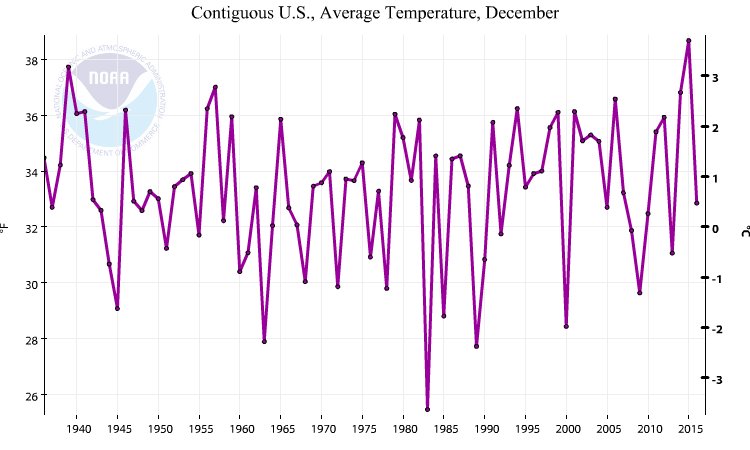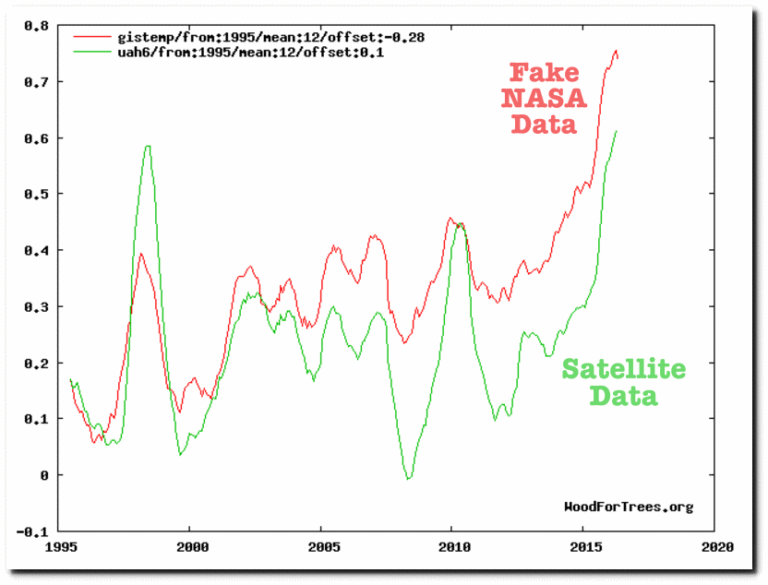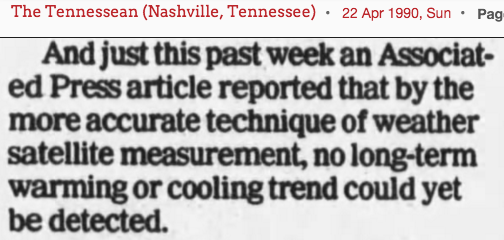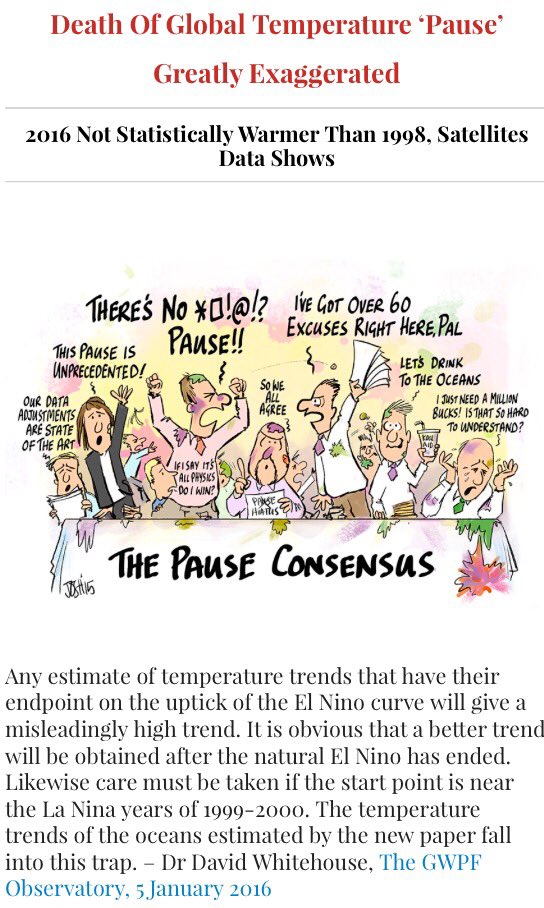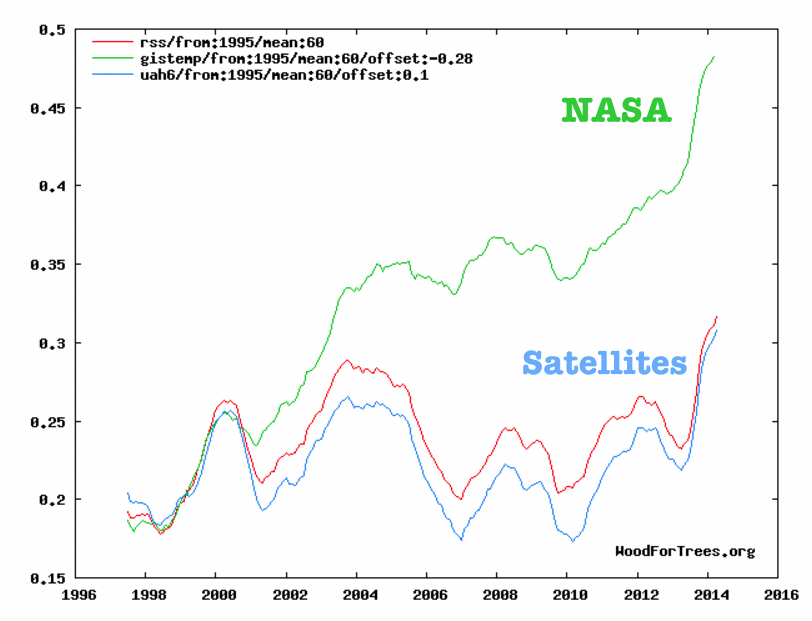Climate Depot Analysis
It’s that time of year again, the annual media ritual of declaring the previous year “the hottest ever!” And as usual, the media and many activists government scientists are playing fast and loose with the temperature data and.
Former Vice President Al Gore promoted the “hottest year” claim today. “2016 was the hottest year on record — confirmed by NASA and NOAA,” Gore tweeted. (More media hype here: CNN: 2016 was the hottest year on record — again & 2016 breaks record for hottest year ever)

But scientists seemed to yawn at the news.
Extreme Weather expert Dr. Roger Pielke Jr. noted that the media “hottest year” scare stories are simply not working. “Selling climate policy on “hottest year ever” hard because 2016 also had very low disasters & record high crop productivity. It doesn’t scare people,” Pielke wrote.

MIT climate scientist Dr. Richard Lindzen, was very blunt. (See: MIT climate scientist on ‘hottest year’: ‘The hysteria over this issue is truly bizarre’ – Warns of return ‘back to the dark ages’)
Lindzen said in an interview on Howie Carr’s radio show: “To imply that a rise of temperature of a tenth of a degree is proof that the world is coming to an end — has to take one back to the dark ages.” He added, “As long as you can get people excited as to whether it’s a tenth of a degree warmer or cooler, then you don’t have to think, you can assume everyone who is listening to you is an idiot.”
“The whole point is so crazy because the temperature is always going up or down a little. What is astonishing is that in the last 20 years it hasn’t done much of anything,” Lindzen continued.
“What they don’t mention is there has been a big El Nino in 2016 and in recent months the temperature has been dropping back into a zero trend level,” he added.
Reality Check on “hottest year” claims:

The story of the ‘hottest year ever’ in one small table:

2016 GLOBAL TEMPERATURE: THE PAUSE NEVER WENT AWAY – ‘HOTTEST’ CLAIMS WITHIN MARGIN OF ERROR – Peter Stott, Acting Director of the Met Office Hadley Centre said, “A particularly strong El Nino event contributed about 0.2C to the annual average for 2016.”
Dr. David Whitehouse of the GWPF noted: “This means that without the El Nino 2016 would have had a global temperature of 0.57+/- 0.1°C which is the same as 2014 and within the errors of 2010 (0.56) and 2005 (0.54). It would also have been in the 95% confidence range of 2013, 2010, 2009, 2007, 2006, 2005, 2003 and 2002. In other words without the El Nino 2016 would have been statistically in the same region as the previous 15 years.”
“According to NOAA 2016 was 0.07°F warmer than 2015, which is 0.04°C. Considering the error in the annual temperature is +/- 0.1°C this makes 2016 statistically indistinguishable from 2015, making any claim of a record using NOAA data specious,” Whitehouse added.
Scientists React to ‘Hottest year’ claims:
Climatologist Dr. Judith Curry: “2015 and 2016 were years with a very strong El Niño.” – “Examination of the satellite data record of atmospheric temperatures, 2016 was only 0.02 degrees Celsius warmer than 1998 — a difference that is not statistically significant,” Curry wrote to the Washington Post today.
Climatologist Dr. Roger Pielke Sr., a senior research scientist at the University of Colorado-Boulder, rejected the way global temperatures are measured. “Unfortunately, the surface temperature analysis contains several uncertainties and systematic biases when used to diagnose global warming,” Pielke Sr. wrote in the Washington Post.
“One of them is with respect to land minimum temperatures over land. Rather than measuring changes in heat content through depth in the atmosphere, even slight changes in vertical mixing of heat (even with no net heating) can produce warmer minimum temperatures,” he wrote.
Physicist Dr. Lubos Motl noted today: There is no ‘canonical’ global mean temp: NASA’s temp trends are “almost 20 times larger than the satellites.”
Motl noted: “Both satellite-based teams quantifying the global mean temperature (UAH AMSU, RSS AMSU) concluded that 2016 was 0.02 °C warmer than 1998. These were otherwise very similar “end of a strong El Niño years” separated by 18 years. According to these numbers and nothing else, one could estimate that the warming per century is some 0.11 °C, a negligible amount.”
He added: “There is no ‘canonical’ global mean temperature. It’s an artificial quantity whose detailed value – and whose detailed change in 18 or 100 years – significantly depends on all the details about how the global mean temperature is defined and measured.”

Climatologist Dr. John Christy, professor of atmospheric science, University of Alabama in Huntsville: “As the world cools now, the global atmospheric temperature change from February to December has been over one degree. 2017 will be cooler than 2016.”
#
Climate Depot Note: Global temperatures have been holding nearly steady for almost two decades (nearly 18 years according to RSS satellite data). See full Climate Report here on latest ‘global warming’ claims.
While 2005, 2010, and 2015, 2016 were declared the ‘hottest years’ by global warming proponents, a closer examination revealed that the claims were “based on year-to-year temperature data that differs by only a few HUNDREDTHS of a degree to tenths of a degree Fahrenheit – differences that were within the margin of error in the data.” In other words, global temperatures have essentially held very steady with no sign of acceleration. The media and climate activists hype ‘record’ temperatures that are not even outside the margin of error of the dataset as somehow meaningful.
Even former NASA climatologist James Hansen admitted ‘hottest year’ declarations are “not particularly important.”
MIT climate scientist Dr. Richard Lindzen ridiculed ‘hottest year’ claims in 2015. “The uncertainty here is tenths of a degree. When someone points to this and says this is the warmest temperature on record, what are they talking about? It’s just nonsense. This is a very tiny change period,” Lindzen said. “If you can adjust temperatures to 2/10ths of a degree, it means it wasn’t certain to 2/10ths of a degree.”
So-called ‘hottest year’ claims are just a fancy way of saying that the ‘global warming pause’ has essentially continued.
Background on “Hottest Year” claims & the “Pause” Or “Hiatus”
‘Hide The Decline’ Unveiled: 50 Non-Hockey Stick Graphs Quash Modern ‘Global’ Warming Claims
Why NYT Hid The Numbers For The ‘Hottest Year On Record’ – By Robert Tracinski: ‘When you read a science report claiming that 2016 was the hottest year on record, you might expect that you will get numbers. And you would be wrong.’ – ‘We are not told what the average global temperature was, how much higher this is than last year’s record or any previous records, or what the margin of error is supposed to be on those measurements….
Note to the New York Times: “trouncing” and “blown past” are phrases appropriate to sports reporting, not science reporting. Except that no sports reporter would dare write an article in which he never bothers to give you the score of the big game. Yet that’s what passes for “science reporting” on the issue of global warming, where asking for numbers and margins of errors apparently makes you an enemy of science. Instead, it’s all qualitative and comparative descriptions. It’s science without numbers…The temperature difference that is supposedly being measured is one one-hundredth of a degree—one tenth the size of the margin of error. To go back to sports reporting, that’s like saying that the football is on the 10-yard line—give or take a hundred yards.’
#
DELINGPOLE: Hottest Year Evah: The Climate Alarmists’ Last Big Scare Story Before Trump
Via Real Climate Science: Satellites show that temperatures in 2016 were nearly identical to 1998. The claims of record warmth are due to massively tampered NOAA/NASA data.
Flashback 1990: AP calls satellite temperatures ‘more accurate’ – But in 2016: AP ignores satellite’s showing 18 year plus ‘standstill’ in global temps -The Tennessean – April 22, 1990: ‘An Associated Press article reported that by the more accurate technique of weather satellite measurement, no long-term warming or cooling trend cold yet be detected.’
NASA also said the satellite’s were ‘more accurate.’ Flashback: 1990 NASA Report: ‘Satellite analysis of upper atmosphere is more accurate, & should be adopted as the standard way to monitor temp change.’ – April 1990 – The Canberra Times: ‘A report Issued by the U.S. space agency NASA…’
The Pause Lives on: Global Satellites: 2016 not Statistically Warmer than 1998 – Climatologist Dr. Roy Spencer: The resulting 2016 annual average global temperature anomaly is +0.50 deg. C, which is (a statistically insignificant) 0.02 deg. C warmer than 1998 at +0.48 deg. C. We estimate that 2016 would have had to be 0.10 C warmer than 1998 to be significantly different at the 95% confidence level. Both 2016 and 1998 were strong El Nino years.
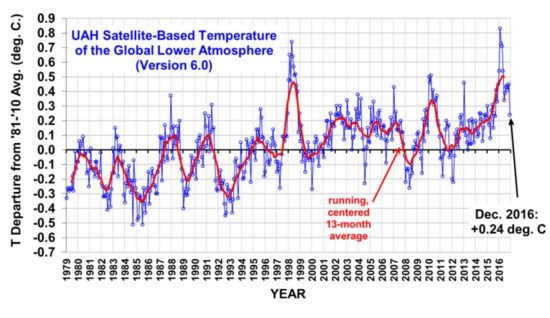
Despite new claims, global warming temperature pause ‘still going strong’
A new study that only looked at ocean temperatures is being trumpeted as disproving the global warming pause – it doesn’t
Dr. Judith Curry: ‘The hiatus is still going strong in the satellite dataset’
Meteorologist Anthony Watts: ‘Yet another study tries to erase “the pause” – but is missing a whole year of data’
Death Of Global Temperature ‘Pause’ Greatly Exaggerated – 2016 Not Statistically Warmer Than 1998
2016 Not Statistically Warmer Than 1998, Satellites Data Shows
Dr David Whitehouse: ‘Any estimate of temperature trends that have their endpoint on the uptick of the El Nino curve will give a misleadingly high trend. It is obvious that a better trend will be obtained after the natural El Nino has ended. Likewise care must be taken if the start point is near the La Nina years of 1999-2000. The temperature trends of the oceans estimated by the new paper fall into this trap.’
Two satellite datasets agree: The Pause lives on: ‘No warming for the last 18 years’
RSS Confirm 2016 Is Tied With 1998 As Warmest Year
As Roy Spencer has pointed out, the margin of error is 0.1C, so statistically 2016 is tied with 1998 as the warmest year in the satellite record. The fact that there has been no warming for the last 18 years is a massive blow to the credibility of climate science.
Even former NASA climatologist James Hansen admitted ‘hottest year’ declarations are “not particularly important.” MIT climate scientist Dr. Richard Lindzen ridiculed ‘hottest year’ claims in 2015. “The uncertainty here is tenths of a degree. When someone points to this and says this is the warmest temperature on record, what are they talking about? It’s just nonsense. This is a very tiny change period,” Lindzen said. “If you can adjust temperatures to 2/10ths of a degree, it means it wasn’t certain to 2/10ths of a degree.” 11 So-called ‘hottest year’ claims are just a fancy way of saying that the ‘global warming pause’ has essentially continued.
While 2005, 2010, and 2015 were declared the ‘hottest years’ by global warming proponents, a closer examination revealed that the claims were “based on year-to-year temperature data that differs by only a few HUNDREDTHS of a degree to tenths of a degree Fahrenheit – differences that were within the margin of error in the data.” In other words, global temperatures have essentially held very steady with no sign of acceleration. The media and climate activists hype ‘record’ temperatures that are not even outside the margin of error of the dataset as somehow meaningful.
US temps in December: flat 1936-2016 https://www.ncdc.noaa.gov/cag/
